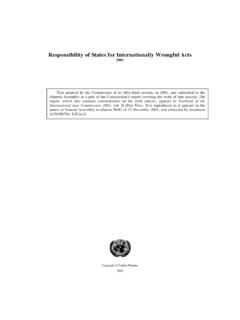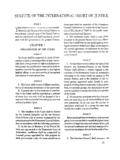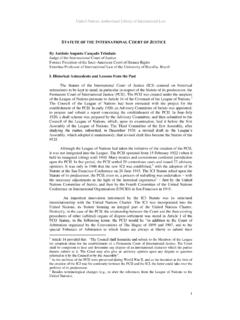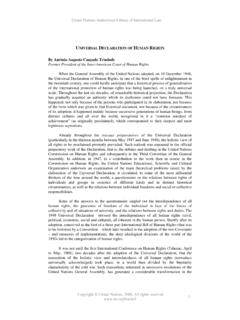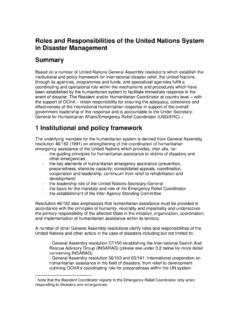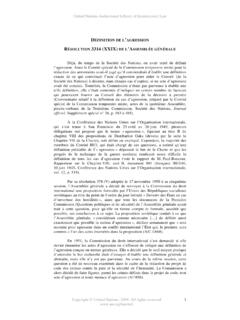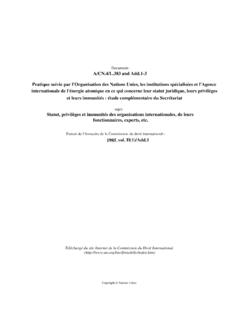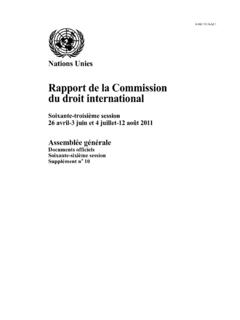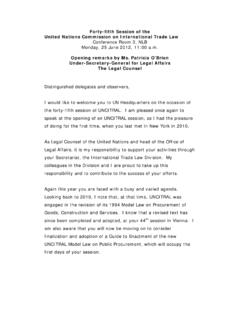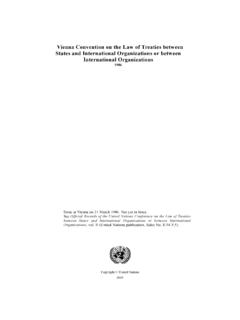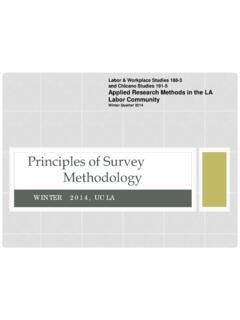Transcription of Draft articles on Prevention of Transboundary Harm from ...
1 Draft articles on Prevention of Transboundary harm from Hazardous Activities, with commentaries 2001 Text adopted by the International Law Commission at its fifty-third session, in 2001, and submitted to the General Assembly as a part of the Commission s report covering the work of that session (A/56/10). The report, which also contains commentaries on the Draft articles , appears in the Yearbook of the International Law Commission, 2001, vol. II, Part Two. Copyright United Nations 2008 1 Report of the International Law Commission on the work of its fifty-third sessiondispute shall, at the request of any of them, have recourse to the establishment of an impartial fact-finding The Fact-finding Commission shall be composed of one member nominated by each party to the dispute and in addition a member not having the nationality of any of the parties to the dis-pute chosen by the nominated members who shall serve as Chair-person.
2 If more than one State is involved on one side of the dispute and those States do not agree on a common member of the Com-mission and each of them nominates a member, the other party to the dispute has the right to nominate an equal number of members of the If the members nominated by the parties to the dispute are unable to agree on a Chairperson within three months of the request for the establishment of the Commission, any party to the dispute may request the Secretary-General of the United Nations to appoint the Chairperson who shall not have the nationality of any of the parties to the dispute. If one of the parties to the dispute fails to nominate a member within three months of the initial re-quest pursuant to paragraph 2, any other party to the dispute may request the Secretary-General of the United Nations to appoint a person who shall not have the nationality of any of the parties to the dispute.
3 The person so appointed shall constitute a single-member The Commission shall adopt its report by a majority vote, unless it is a single-member Commission, and shall submit that report to the parties to the dispute setting forth its findings and recommendations, which the parties to the dispute shall consider in good text Of the Draft articles with COmmentaries theretO98. The text of the Draft articles adopted by the Commis-sion at its fifty-third session with commentaries thereto is reproduced OF Transboundary harm FROM HAZARDOUS ACTIVITIESG eneral commentary(1) The articles deal with the concept of Prevention in the context of authorization and regulation of hazardous activities which pose a significant risk of Transboundary harm .
4 Prevention in this sense, as a procedure or as a duty, deals with the phase prior to the situation where signifi-cant harm or damage might actually occur, requiring States concerned to invoke remedial or compensatory measures, which often involve issues concerning liability.(2) The concept of Prevention has assumed great sig-nificance and topicality. The emphasis upon the duty to prevent as opposed to the obligation to repair, remedy or compensate has several important aspects. Prevention should be a preferred policy because compensation in case of harm often cannot restore the situation prevail-ing prior to the event or accident. Discharge of the duty of Prevention or due diligence is all the more required as knowledge regarding the operation of hazardous activi-ties, materials used and the process of managing them and the risks involved is steadily growing.
5 From a legal point of view, the enhanced ability to trace the chain of causa-tion, the physical link between the cause (activity) and the effect ( harm ), and even the several intermediate links in such a chain of causation, makes it also imperative for operators of hazardous activities to take all steps neces-sary to prevent harm . In any event, Prevention as a policy is better than cure.(3) Prevention of Transboundary harm arising from haz-ardous activities is an objective well emphasized by prin-ciple 2 of the Rio Declaration on Environment and Devel-opment (Rio Declaration)857 and confirmed by ICJ in its advisory opinion on the Legality of the Threat or Use of Nuclear Weapons858 as now forming part of the corpus of international law.
6 (4) The issue of Prevention , therefore, has rightly been stressed by the Experts Group on Environmental Law of the World Commission on Environment and Development (Brundtland Commission). Article 10 recommended by the Group in respect of Transboundary natural resources and environmental interferences thus reads: States shall, without prejudice to the principles laid down in articles 11 and 12, prevent or abate any Transboundary environmental interference or a significant risk thereof which causes sub-stantial harm harm which is not minor or insignifi-cant. 859 It must be further noted that the well-established principle of Prevention was highlighted in the arbitral award in the Trail Smelter case860 and was reiterated not only in principle 21 of the Declaration of the United Na-tions Conference on the Human Environment (Stockholm Declaration)861 and principle 2 of the Rio Declaration, but also in General Assembly resolution 2995 (XXVII) of 15 December 1972 on cooperation between States in the field of the environment.
7 This principle is also reflected in principle 3 of the Principles of conduct in the field of the environment for the guidance of States in the conservation and harmonious utilization of natural resources shared by two or more States, adopted by the Governing Council of UNEP in 1978, which provided that States must: avoid to the maximum extent possible and .. reduce to the minimum extent possible the adverse environmental effects beyond its jurisdic-tion of the utilization of a shared natural resource so as to protect the environment, in particular when such utilization might: (a) cause damage to the environment which could have repercus-sions on the utilization of the resource by another sharing State; (b) threaten the conservation of a shared renewable resource; (c) endanger the health of the population of another State.
8 6 Report of the United Nations Conference on Environment and Development, Rio de Janeiro, 3 14 June 1992 (United Nations publica-tion, Sales No. and corrigenda), vol. I: Resolutions adopted by the Conference, resolution 1, annex I. Legality of the Threat or Use of Nuclear Weapons (see footnote 54 above), pp. 241 242, para. 29; see also A/51/218, annex. 9 Environmental Protection and Sustainable Development: Legal Principles and Recommendations (London, Graham and Trotman/ Martinus Nijhoff, 1987), p. 75, adopted by the Experts Group. It was also noted that the duty not to cause substantial harm could be deduced from the non-treaty-based practice of States, and from the statements made by States individually and/or collectively.
9 See J. G. Lammers, Pollution of International Watercourses (The Hague, Martinus Nijhoff, 1984), pp. 346 347 and 374 376. 60 Trail Smelter (see footnote 253 above), pp. 1905 et seq. 61 Report of the United Nations Conference on the Human Envi-ronment, Stockholm, 5 16 June 1972 (United Nations publication, Sales No. and corrigendum), part one, chap. I. 6 UNEP, Environmental Law: Guidelines and Principles, No. 2, Shared Natural Resources (Nairobi, 1978), p. 2. The principles are re- International liability for injurious consequences arising out of acts not prohibited by international law 1 9(5) Prevention of Transboundary harm to the environ-ment, persons and property has been accepted as an im-portant principle in many multilateral treaties concerning protection of the environment, nuclear accidents, space objects, international watercourses, management of haz-ardous wastes and Prevention of marine PreambleThe States Parties,Having in mind Article 13, paragraph 1 (a)
10 , of the Charter of the United Nations, which provides that the General Assembly shall initiate studies and make recommendations for the purpose of encouraging the progressive development of international law and its codification,Bearing in mind the principle of permanent sover-eignty of States over the natural resources within their territory or otherwise under their jurisdiction or con-trol,Bearing also in mind that the freedom of States to carry on or permit activities in their territory or oth-erwise under their jurisdiction or control is not unlim-ited,Recalling the Rio Declaration on Environment and Development of 13 June 1992,Recognizing the importance of promoting interna-tional cooperation,Have agreed as follows:Commentary(1) The preamble sets out the general context in which the topic of Prevention is elaborated, keeping in view the mandate given to the Commission to codify and develop international law.
